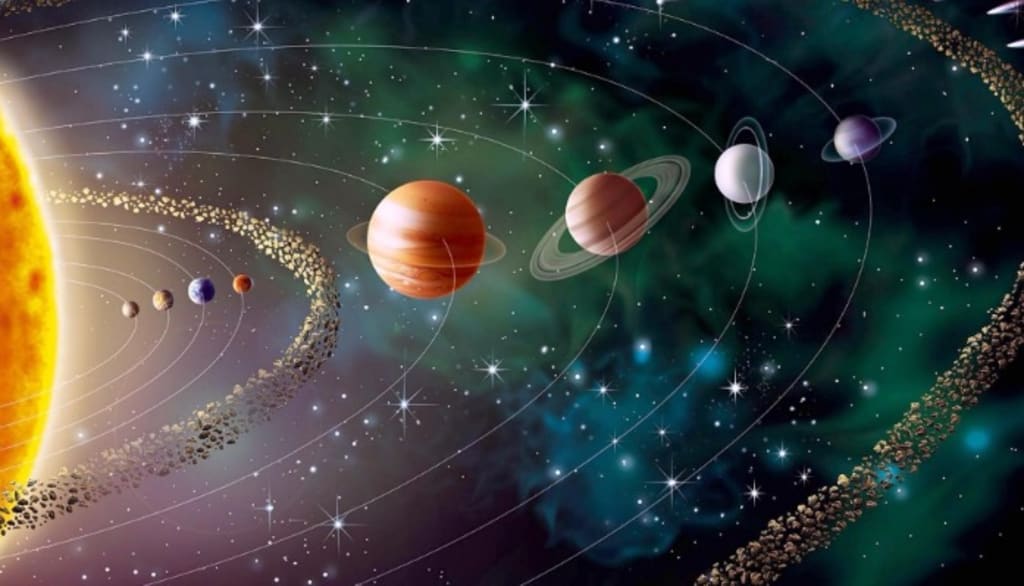STORY OF OUR GALAXY AND SOLAR SYSTEM
Galaxy and Big Bang Theory

The story of our galaxy and solar system unfolds as a narrative, describing the journey from the earliest phases after the Big Bang to the formation of stars, planets, and celestial bodies. It depicts the evolution of our universe, detailing the complexities of cosmic events, planetary formation, and the development of conditions favourable for life. Imagine a vast, swirling galaxy composed of billions of stars, dust, and gas, shaped like a colossal pinwheel or a graceful spiral. Within this grand galaxy, envision our solar system: a central star, the Sun, surrounded by planets, moons, asteroids, and comets orbiting around it. Each planet, unique in size, composition, and features, follows its path around the Sun, while moons orbit planets, creating a cosmic dance of orbits and gravitational pulls. This captivating image showcases the beauty and complexity of our galaxy and the intricate arrangement of our solar system within it. Our galaxy, the Milky Way, is a vast spiral structure composed of billions of stars, celestial gas, dust, and various celestial objects. Its appearance is like a massive, flattened disk with spiral arms extending outward from a central bulge. Within this stunning cosmic structure, our solar system resides in one of the spiral arms, known as the Orion Arm or Local Spur. The Milky Way spans around 100,000 light-years in diameter, and it's home to numerous stars, star clusters, nebulae, and other intriguing celestial phenomena. Its mesmerizing beauty and immense size make it a captivating spectacle in the night sky and a subject of fascination for astronomers and stargazers alike.
The Big Bang Theory, instead of detailing the precise start of our Cosmos, narrates events following its earliest phases. This period saw stars, galaxies, and specks of matter compressed into a tiny dot, akin to a peach, with a temperature surpassing a trillion degrees. Contrary to an explosion at a specific point, it marked the onset of space expanding uniformly—termed inflation. Initially, the cosmos was much smaller, resembling a plasma that eventually cooled, forming the first atoms. This process released immense radiation, evident in the cosmic microwave background (CMB), a fossil of that early radiation around 380,000 years after the Big Bang. Subsequently, as matter cooled and became transparent, light could emerge, enabling the formation of light elements like hydrogen and helium.
Over time, roughly 400 million years post-Big Bang, the universe emerged from its Dark Ages, leading to the formation of the first stars and galaxies. Our solar system took shape from a dense cloud of interstellar dust and gas, possibly disrupted by a nearby supernova. This disruption formed a spinning solar nebula, eventually giving rise to our Sun and the diverse celestial bodies within our system. Planetary formation involved dust particles colliding and growing into rocks, subsequently forming planets of varying compositions and sizes.
Further chaos in the early solar system led to the creation of dwarf planets, moons, and the asteroid belt, while significant collisions, like the one between a Mars-sized planet and Earth, formed our Moon. As time passed, the Sun evolved from a ball of helium and hydrogen to the shining star we know, set to last for billions of years.
The early solar system witnessed significant gravitational interactions, likely altering the orbits of giant planets like Saturn and Jupiter, potentially affecting the positions of Uranus and Neptune. These interactions might have also influenced the distribution of objects in the Kuiper belt and Oort Cloud. These collisions and interactions potentially brought organic matter and water to Earth, crucial for the development of life around 3.8 to 3.5 billion years ago. This period also saw evidence of microbial life in structures like stromatolites.
Mars, with a history of water and a potential for life, lost its atmosphere due to internal cooling, unlike Earth, which maintained conditions suitable for life's evolution. Earth eventually developed photosynthetic organisms, leading to the oxygenation of the atmosphere, facilitating the emergence of complex life forms.
Within our solar system's history, Saturn's rings and lunar impacts represent significant events, alongside catastrophic events like the asteroid impact 66 million years ago, triggering substantial climate changes and causing mass extinctions, including that of dinosaurs.
About the Creator
Malika Khan
I'm a med student who enjoys diving into books and crafting stories, gardening, cooking and baking, exploring new places, & engaging in playful activities. In my free time, I relish moments spent chatting with both the elderly and children.
Enjoyed the story? Support the Creator.
Subscribe for free to receive all their stories in your feed. You could also pledge your support or give them a one-off tip, letting them know you appreciate their work.





Comments
There are no comments for this story
Be the first to respond and start the conversation.